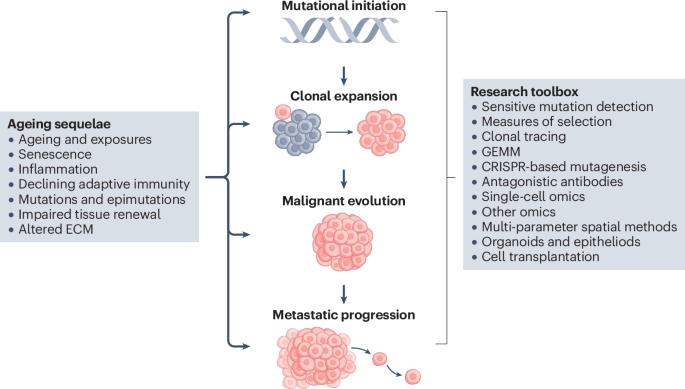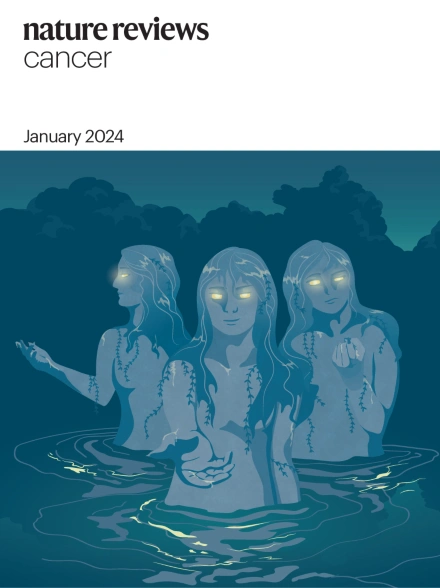癌症进化轨迹的衰老依赖性建模
IF 66.8
1区 医学
Q1 ONCOLOGY
引用次数: 0
摘要
衰老是癌症发展的唯一最重要的预后因素。尽管有这些知识,癌症的实验模型在历史上忽略了年龄对癌症发生、进展和治疗结果的影响。衰老与其他生活方式因素相互作用,包括吸烟、肥胖和体育锻炼,但这些相互作用很少在实验模型中得到研究。鉴于与癌症相关的死亡率随着年龄的增长而增加,在癌症研究中越来越强调对与年龄相关的突变和微环境变化进行建模。在这篇综述中,我们提供了技术进步和实验策略的指导,这些技术进步和实验策略提高了我们模拟衰老如何影响癌症进化的各个阶段的能力,从突变驱动的克隆扩增,到恶性病变,然后发展到更恶性的表型和转移,以及对治疗的反应。我们讨论了所使用的方法和模型的优点和局限性。更广泛地采用与年龄相适应的癌症模型,将能够发展出更好的方法来检测、预防和治疗人类癌症。本文章由计算机程序翻译,如有差异,请以英文原文为准。


Modelling the ageing dependence of cancer evolutionary trajectories
Ageing is the single most important prognostic factor for cancer development. Despite this knowledge, experimental models of cancer have historically omitted incorporating the impact of age on cancer initiation, progression and treatment outcomes. Ageing interacts with other lifestyle factors, including cigarette smoking, obesity and physical activity, but these intersections are rarely studied in experimental models. Given that cancer-related mortality rates increase with age, there is a growing emphasis on modelling ageing-associated mutational and microenvironmental changes in cancer research. In this Review, we provide guidance on the technological advancements and experimental strategies that have increased our ability to model how ageing impacts various stages of cancer evolution, from mutation-driven clonal expansions, to pre-malignant lesions, and then to progression to more malignant phenotypes and metastasis, and responses to therapies. We discuss the benefits and limitations of methods and models used. The wider adoption of age-appropriate models of cancer will enable the development of improved approaches for the detection, prevention and therapeutic intervention of human cancers. In this Review, Henry and DeGregori discuss the contributions of the various models and methods used to study the connection between ageing and cancer, highlighting the strengths and limitations of those models and technologies, as well as advocating for the wider adoption of age-appropriate models of cancer to improve our clinical translation of approaches to prevent and treat human cancers.
求助全文
通过发布文献求助,成功后即可免费获取论文全文。
去求助
来源期刊

Nature Reviews Cancer
医学-肿瘤学
CiteScore
111.90
自引率
0.40%
发文量
97
审稿时长
6-12 weeks
期刊介绍:
Nature Reviews Cancer, a part of the Nature Reviews portfolio of journals, aims to be the premier source of reviews and commentaries for the scientific communities it serves. The correct abbreviation for abstracting and indexing purposes is Nat. Rev. Cancer. The international standard serial numbers (ISSN) for Nature Reviews Cancer are 1474-175X (print) and 1474-1768 (online). Unlike other journals, Nature Reviews Cancer does not have an external editorial board. Instead, all editorial decisions are made by a team of full-time professional editors who are PhD-level scientists. The journal publishes Research Highlights, Comments, Reviews, and Perspectives relevant to cancer researchers, ensuring that the articles reach the widest possible audience due to their broad scope.
 求助内容:
求助内容: 应助结果提醒方式:
应助结果提醒方式:


